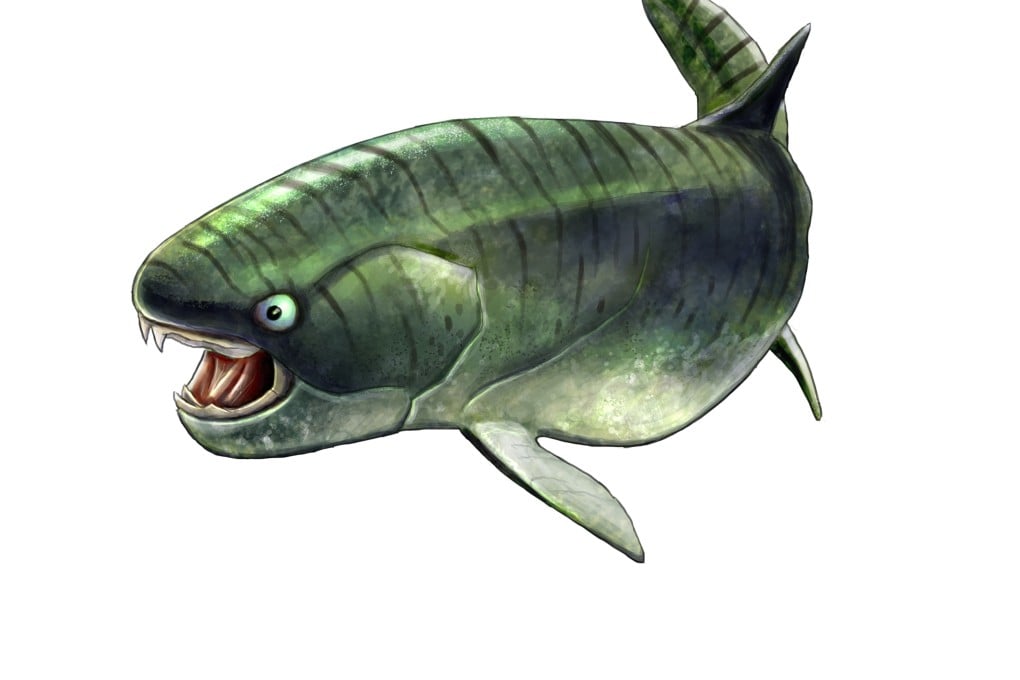





The placoderm was an armoured fish that lived 400 million years ago!


The placoderm was an armoured fish that lived 400 million years ago!


Fossils are the preserved remains of ancient animals. They are usually found in places such as deserts with sedimentary rocks.
But in Hong Kong, the rocks are mostly granite or volcanic. This makes it tricky to hunt for fossils here, but that does not mean there aren't any. Palaeontologists need a strong understanding of geography, some perseverance, and tons of luck to find impressive fossils in Hong Kong.
Hong Kong's fossils
Our city's first fossil was found in 1920. It was an ammonite, which is an extinct shelled sea creature related to squid, octopus and cuttlefish. The fossil was from the Jurassic period about 190 million years ago.
But being the first found does not mean it is the oldest. That title goes to a marine animal called the placoderm, also called an armoured fish. It existed 400 million years ago. Its fossil was found in 1980 on the coast of the Tolo Channel, in the New Territories.
This exciting discovery expanded our knowledge of Hong Kong's geological history, which goes back to the Devonian period about 400 million years ago.
By examining the rocks surrounding these fossils, scientists could tell that the environment back then was probably a fluvial plain or delta.
A fluvial plain is flat land. It is created when rivers flowing from highland regions leave sediment over a long period of time. A delta is a wetland where the fresh water meets the salt water, and rivers leave sediment to form an area shaped like a triangle.
New fossils are still found in Hong Kong. The newest discovery last year was an ammonite piece and fossil containing evidence of early life forms in mudflats. There is always the chance to uncover new traces of prehistoric life and, perhaps, even dinosaurs!
More about placoderms
Placoderms are a kind of prehistoric armoured fish that first appeared during the Silurian period 443 million years ago. The name placoderm means "plated skin". They were among the first animals to evolve jaws. They had inside skeletons like sharks, but they also had an armour-like outside skeleton made up of bony plates covering their head.
Placoderms were the most abundant group of fish during the Devonian period, which was 419 to 359 million years ago.
Placoderms lived in oceans, rivers and lakes. They could be as small as a few centimetres and as big as great white sharks, which are more than 3 metres long. They ate almost anything, including invertebrates, other fish and even other placoderms.
Placoderms dominated the marine world for more than 200 million years before the first dinosaurs appeared. Sadly, like most marine life during this time, they disappeared during the extinction event at the end of the Devonian period.
Fun facts
Without fossils, we wouldn’t know about dinosaurs. Some fossils are of footprints, rather than the animals themselves. Scientists have found fossils of feathered dinosaurs!
Quick questions
- What does "placoderm" mean?
- What kind of rocks are usually found in Hong Kong?
- Have any fossils recently been discovered here?



the parts of something that are left after the other parts have been used, eaten, removed, etc.
the quality of continuing to try to achieve a particular aim despite difficulties
sand, stones, mud, etc. carried by water or wind and left, for example, on the bottom of a lake, river, etc.
the facts, signs or objects that make you believe that something is true
existing in large quantities; more than enough

the parts of something that are left after the other parts have been used, eaten, removed, etc.
the quality of continuing to try to achieve a particular aim despite difficulties
sand, stones, mud, etc. carried by water or wind and left, for example, on the bottom of a lake, river, etc.
the facts, signs or objects that make you believe that something is true
existing in large quantities; more than enough